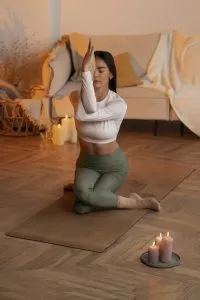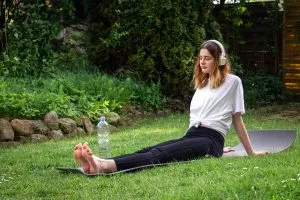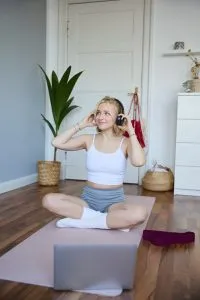I’m always on the look out for how to keep my health at it’s best. Luckily for me I happen to love both the practice of yoga and also that of meditation.
Yoga and meditation are two ancient practices that have been used for thousands of years to enhance physical, mental, and spiritual well-being.
Both originating in India and are rooted in Hinduism, Buddhism, and other traditions.
But I have wondered what the benefits of combining these two practices?
How can they help us achieve a higher state of consciousness and harmony?

Yoga
Yoga’s a type of meditative movement that involves specific physical postures and poses, as well as a focus on deep breathing.
It improves our flexibility, strength, balance, endurance, and mindfulness.
It can also reduce stress, anxiety, depression, inflammation, and chronic pain.
There are different styles and intensities of yoga, ranging from gentle and slow to vigorous, fast and even hot!
Some yoga styles also include chanting, mantra, and other meditation style methods.
Meditation
Meditation is a practice of focusing the mind on a single object, thought, sensation, or awareness.
Meditation can help you calm and center your mind, as well as increase your attention, memory, learning, and creativity.
It’s been known to lower your blood pressure, heart rate, and cortisol levels, as well as boost your immune system and mood.
As with yoga, there are many different types of meditation, including mindfulness, transcendental, zen, vipassana, and guided.
Combining Yoga and Meditation

When you combine yoga and meditation, you can experience a synergy that seems to improve both practices.
Yoga prepares your body and mind for meditation, by relaxing your muscles, improving your posture, and increasing your oxygen intake.
Meditation deepens your yoga practice, by allowing you to connect with your inner self, nature, and the universe.
Together, yoga and meditation can help you achieve a state of bliss, peace, and harmony.
Frontiers in Psychology says that “In summary, mindfulness meditation training combined with group yoga intervention for patients with depression can effectively improve the depression and anxiety status of patients, improve the cognitive level of patients with depression, and improve the quality of life, which is worthy of clinical application”.
The Power of Synergy
Physical and Mental Health: Yoga enhances physical well-being through postures and controlled breathing. Meditation nurtures mental health by promoting mindfulness and emotional balance. Together, they create a holistic approach to health.
Stress Reduction: Yoga reduces physical tension, and meditation calms the mind. This combination is a powerful stress-relief strategy, helping you cope with the challenges of every day life. According to Healthline, both movement-based yoga therapies and breathing-based practices have been shown to significantly improve depressive symptoms.
Science Direct conducted a study of medical students who took up Hatha yoga and meditation and said that “they had a decreased physical and physiological symptoms related to stress”.
Enhanced Mindfulness: Yoga postures require your focus and concentration, preparing your mind for meditation. Meditative practices, in turn, support a deeper connection with your body during yoga.
Improved Self-Awareness: Yoga encourages self-awareness through the physical body. Meditation deepens that self-awareness by exploring your thoughts and emotions. Together, they offer a profound understanding of the self.
I have personally found the combination of yoga and meditation to be life changing. I usually start with some yoga poses for opening up the spine and preparing the body. Then I feel like I’m more receptive when I begin meditation.
How to Combine Yoga and Meditation
Incorporating both yoga and meditation into your routine can be a transformative experience. Here’s how you can get started:
Choose a Quiet Space: Find a peaceful area where you can practice without distractions.
Use a Yoga Mat: A comfortable mat provides cushioning and support for the yoga postures.
Start with Yoga: Begin your session with a series of yoga asanas to prepare your body. Focus on your breath and be present in each posture.
Transition to Meditation: After your yoga practice, transition seamlessly into meditation. Find a comfortable seated or lying position. Normally, I find it easiest to just lay down on the yoga mat. Focus on your breath, a mantra, or simply observe your thoughts.
Combine Breathing: Deep, mindful breathing is a common thread in both practices. Use your breath as a bridge between yoga and meditation, bringing awareness to each moment.
Set Realistic Goals: Start with a manageable duration for each practice. Over time, you can increase the length of your sessions.
Be Consistent: The key to reaping the benefits of yoga and meditation is consistency. Make them a daily or weekly ritual.
I normally find that if I do say 10-15 minutes of yoga asanas, then I continue for another 30 minutes with my meditation. This is just what works for me so test it out and see what’s best for you.

The Rewards of The Journey
If you are interested in trying yoga and meditation, you can always start by finding a class, a teacher, a book, or an online resource that suits your level and style.
You can also practice at home as per the above instructions, follow a video, an app, or your own intuition.
The most important thing is to be consistent, patient, and open-minded.
Yoga and meditation are not a quick fix, but more of a lifelong journey of discovery and transformation.
Related posts:
- Thick Yoga Mats For Elderly Practitioners, Tried and Tested by Yoga Teachers For Maximum Support
- Yoga Mat Environmental Impact – The Truth About Traditional Yoga Mats!
- 7 Signs It’s Time to Replace Your Sustainable Yoga Mat
- Yoga Mats for Different Body Types – Finding the Right Support for Your Frame





